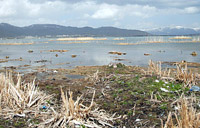It’s no secret that we Armenians are a little skeptical about ecological issues. For example, if they ask a question to Armenians to what extent they are worried about the climate change, which is one of the key issues in the world many people would answer that we have more serious issues.
The cold-heartedness, which is so characteristic to Armenians, may be explained with the fact that they are most interested in social-economic issues. It means that people are more worried about the current day than the future. The second reason is the lack of information. For example, a few people know about the hazards, which the climate change implies if the temperature increases by 1-2 degrees. According to the data of the center of the climate change of Armenia the calculations have showed that in Armenia the air temperature will increase by 1.70 degrees Celsius by 2100 and the precipitation will decrease by 10%. “What’s 1.7 degrees to worry about,” may ask many people. In fact this may have a stronger impact on our lives than we can imagine. Thus, this pan-planet change and the internal microclimatic changes in the territory of Armenia may cause the following consequences:
-It is anticipated that the boundaries of landscape movements will shift upward to the altitude of 100-150 meters. It is expected that the area of the desert and the semi-desert will expand by 33% and a 4% steppe-zone expansion will take place up to 100-200 meters.
-The space of sub-Alps zone will reduce by 21% and the Alpian zone will be cut by 22%.
-In the event of the expected temperature rise and decrease of precipitation we should expect increase of dry climate and acceleration of expansion of desert areas.
-Decrease of the annual flow of rivers will be registered up to 15% and evaporation of lake Sevan up to 13-14%.
-In the expected change of climate, depending on vegetation stage and altitude of the location land moisture of 10-30% is expected.
-The fertility of plants in Armenia may reduce by 8-14%. The fertility of grain plants will be cut at average by 9-13%, the vegetables by 7-14%, potato – by 8-10%, etc. The fertility of dry-resistant grapes species may increase by 8-10%.
-It is expected that the fertility of lands for cattle-breeding will be reduced by 4-10% as well as decrease of fertile lands by 19-22%. In regard of that 30% cut of the number of cattle will be registered and a decrease of cattle-made goods will be cut by 28-33%. In conditions of climate change it is expected that the number of cases of artery diseases will be increased especially among the vulnerable groups of the population. It was revealed that the possibility of plague will be increased. The possibility of malaria is also expected. According to predictions, the plague of cholera may also increase. Increase of stomach diseases will be increased because of the increase of germs in the water and land. We think that this list is enough to envisage what important issues we have to deal with. So if we don’t follow the principle, “after me even flood,” then it would be right to contemplate around this.

